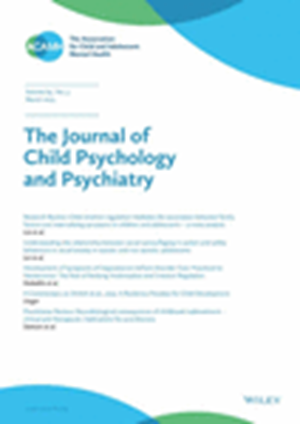Long-term follow-up of a randomised controlled trial of a brief home-based parenting intervention to reduce behavioural problems in young children.
IF 7
1区 医学
Q1 PSYCHIATRY
引用次数: 0
Abstract
BACKGROUND Behaviour problems are common in childhood and are associated with higher rates of mental health problems, educational and relationship difficulties throughout life. This study assessed whether a Video-feedback Intervention to promote Positive Parenting and Sensitive Discipline (VIPP-SD) has sustained benefit 6 years after delivery. It had previously been shown to reduce behavioural problems in children aged 2 and 4 years old. METHODS The Healthy Start, Happy Start study was a 2-arm, multisite randomised clinical trial conducted in 6 NHS trusts in England. Participants (N = 300) were parents/caregivers of children (aged 12-36 months) at risk of behaviour problems. Participants were randomised to receive either VIPP-SD (n = 151) or usual care (n = 149). Those allocated to VIPP-SD were offered 6 home-based video-feedback sessions. Six-year follow-up data were collected from May 2022 to July 2023. The primary outcome was the total score on Parental Account of Children's Symptoms (PACS). The analysis used prespecified longitudinal Bayesian models to handle missing data, and findings are reported as posterior probabilities of superiority alongside treatment effect estimates with 95% credible interval. RESULTS Analysis included 294 of the 300 participants, with 6-year primary outcome data available for 244/300 (81%) (106 girls [43%]; mean age, 8.2 years). The probability of superiority for VIPP-SD on PACS was 86%. The mean difference in the total PACS score was -1.23 (95% Cred.I [-3.34, 0.90]); d = -0.11 (95% Cred.I [-0.032, 0.09]), with fewer behavioural problems in children in the VIPP-SD group (mean [SD] score of 25.30 [9.63] vs. 26.36 [11.05]). CONCLUSIONS This trial found a probability of 86% that VIPP-SD was superior for reducing behaviour problems in children up to 6 years later. Taken together with the earlier positive trial findings, this suggests a small enduring positive impact of a brief early intervention with potential for scaling.一项随机对照试验的长期随访研究,以家庭为基础的短期父母干预来减少幼儿的行为问题。
背景:行为问题在儿童时期很常见,并与一生中较高的心理健康问题、教育和人际关系困难有关。本研究评估了视频反馈干预促进积极育儿和敏感管教(VIPP-SD)是否在分娩后6年持续受益。之前的研究表明,它可以减少2岁和4岁儿童的行为问题。方法“健康开始,快乐开始”研究是一项在英国6家NHS信托机构进行的两组、多地点随机临床试验。参与者(N = 300)是有行为问题风险的儿童(12-36个月)的父母/照顾者。参与者被随机分配接受VIPP-SD (n = 151)或常规护理(n = 149)。分配到VIPP-SD的学生进行了6次家庭视频反馈。从2022年5月至2023年7月收集了六年的随访数据。主要结局是父母儿童症状报告(PACS)的总分。分析使用预先指定的纵向贝叶斯模型来处理缺失数据,研究结果报告为后验优势概率和治疗效果估计,可信区间为95%。结果纳入了300名参与者中的294名,其中244名(81%)有6年的主要结局数据(106名女孩[43%],平均年龄8.2岁)。VIPP-SD在PACS上的优势概率为86%。总PACS评分的平均差异为-1.23 (95% credit。I [-3.34, 0.90]);d = -0.11 (95%)I [-0.032, 0.09]), VIPP-SD组儿童的行为问题较少(平均[SD]评分为25.30[9.63]对26.36[11.05])。结论:该试验发现,在减少儿童6年后的行为问题方面,VIPP-SD的成功率为86%。结合早期的积极试验结果,这表明短暂的早期干预具有小规模的持久积极影响,并有可能扩大规模。
本文章由计算机程序翻译,如有差异,请以英文原文为准。
求助全文
约1分钟内获得全文
求助全文
来源期刊
CiteScore
13.80
自引率
5.30%
发文量
169
审稿时长
1 months
期刊介绍:
The Journal of Child Psychology and Psychiatry (JCPP) is a highly regarded international publication that focuses on the fields of child and adolescent psychology and psychiatry. It is recognized for publishing top-tier, clinically relevant research across various disciplines related to these areas. JCPP has a broad global readership and covers a diverse range of topics, including:
Epidemiology: Studies on the prevalence and distribution of mental health issues in children and adolescents.
Diagnosis: Research on the identification and classification of childhood disorders.
Treatments: Psychotherapeutic and psychopharmacological interventions for child and adolescent mental health.
Behavior and Cognition: Studies on the behavioral and cognitive aspects of childhood disorders.
Neuroscience and Neurobiology: Research on the neural and biological underpinnings of child mental health.
Genetics: Genetic factors contributing to the development of childhood disorders.
JCPP serves as a platform for integrating empirical research, clinical studies, and high-quality reviews from diverse perspectives, theoretical viewpoints, and disciplines. This interdisciplinary approach is a key feature of the journal, as it fosters a comprehensive understanding of child and adolescent mental health.
The Journal of Child Psychology and Psychiatry is published 12 times a year and is affiliated with the Association for Child and Adolescent Mental Health (ACAMH), which supports the journal's mission to advance knowledge and practice in the field of child and adolescent mental health.

 求助内容:
求助内容: 应助结果提醒方式:
应助结果提醒方式:


